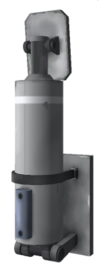LT-2 Landing Strut
| LT-2 Landing Strut | ||
| Landing leg by Moving Parts Experts Group | ||
| Radial size | Radial mounted | |
| Cost | (total) | 340.00 |
| Mass | (total) | 0.100 t |
| Drag | 0.2 | |
| Max. Temp. | 2000 K | |
| Impact Tolerance | 12 m/s | |
| Research | | |
| Unlock cost | 4 100 | |
| Since version | 0.14 | |
| Part configuration | landingLegLT-2.cfg | |
| Retractable | Yes | |
| Brake torque | No | |
| Steering range | No | |
| Packed volume | 300 l | |
The LT-2 Landing Stut is primarily used to land safely on celestial bodies. Prior to its introduction in 0.14, winglets were often the preferred method of providing landing legs for Mün missions.
Usage
The LT-2 Landing Strut is used as a landing support when landing vertically. It is connected radially and extends with the G key (Default). It extends much farther than the smaller cousin LT-1 through a unique telescoping action, making it suitable for landers with larger engines.
Although comparatively long, LT-2 landing struts still need to be placed low on a rocket. They do extend far enough to be used with LV-T30 or LV-T45 Liquid Fuel Engines, but cannot reach past the LV-N or Mainsail.
LT-2 Landing struts start in an folded state, and will need to be extended. This is done with the “G” key or hitting the “extend gear” button on the HUD. While in motion the legs can produce substantial forces, potentially resulting in a several meter “hop”. If the leg collides with another part of the rocket, it can break connections and push that part away.
The maximum safe landing speed for an LT-2 landing strut is ~12 m/s. Landings with massive rockets or on rough terrain may need to be slower to avoid ripping off landing legs.
As of 0.23.5, landing leg mass is counted. This is in contrast to landing gear.
Description
| “ | The LT-2 Landing Strut offers a heavy-duty method for planting yourself firmly on the ground, without the severe consequences that usually accompany planting yourself firmly on the ground. — Moving Parts Experts Group |
” |
Changes
- Suspension
- Initial Release

